If you’re a parent you have likely considered getting your child a pet at some point. A child can benefit in many ways by being responsible for the life of a small animal. As an animal lover and parent myself, I have gotten a variety of different pets for my children.
But what kind of pet should you get for your child? The most popluar option is of course to get your child a puppy. Other common options include things like corn snakes, guinea pigs, hamsters, reptiles, and cats. While each of these animals can make great pets, my aim is to convince you that you should consider fish instead.
Reasons Fish Make Great Pets For Kids
Why do fish make great pets for kids? There are a variety of reasons. Some of them are common to all pets. Others are unique to fish. Either way, you will find these are all great reasons.
So let’s dive in and explore the top 8 reasons fish make great pets for kids!
1. Pet Fish Can’t Escape
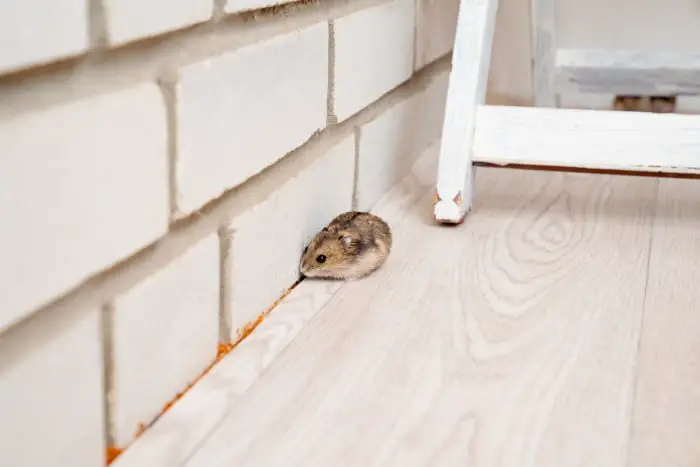
Would the thought of a loose mouse, gerbil, or even a snake keep you up at night? Many types of small pets recommended for children want nothing more than to escape confinement. This has happened in my home more than once. Sometimes we can’t even find the little fugitive for days!
Children are still learning responsibility and make mistakes. They may not secure a lid tightly, or at all. Even if they do a good job with the lid, a squirmy pet may still wiggle its way out of their grasp. In any case, this is a very real concern and something that should be considered.
The good news is this isn’t something you need to worry about with pet fish! While some fish do jump, a decent aquarium lid prevents any such mishaps.
2. Great Tool to Educate & Teach Responsibility
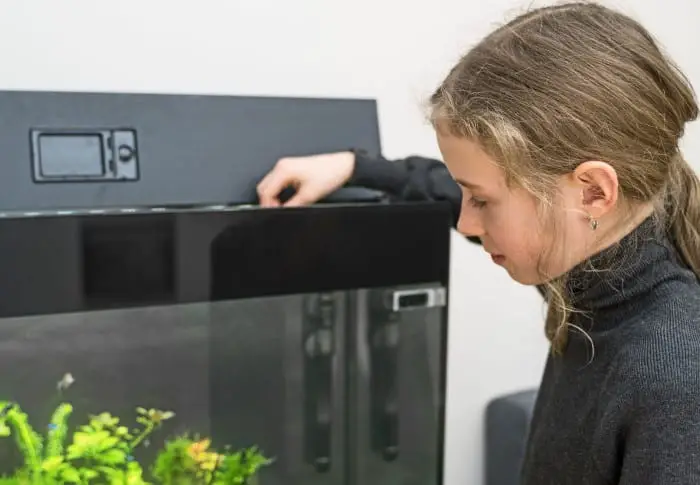
There is a great deal that a child can learn when caring for an aquarium full of fish. I’d even go as far as to say they will learn more than with any other pet. They will learn about responsibility, water chemistry, water filtration, temperature, breeding & genetics, biology, and even death.
With such a broad category of things to learn children as young as preschoolers and as old as teenagers all have something to learn.
At the preschool-age children can be given the responsibility of daily feedings. In addition to responsibility, they will also learn that like themselves, fish get hungry and need food to survive. They can also learn that different types of aquatic pets need different kinds of food.
As they get older they can be taught how to clean and maintain an aquarium. This includes learning a little bit about the nitrogen cycle, water chemistry, and temperature.
This may also be a great time to start introducing concepts such as breeding and genetics.
Livebearers, or fish that give birth to live free-swimming young, are great for this. Fancy guppies are my favorite due to their wide variety of bright colors. By breeding guppies, a child can learn about heredity, genotype, and phenotype.
It’s very interesting to see the offspring that two different colored guppy parents produce!
Inevitably, your child also has the opportunity to learn about death. Fish are short-lived animals and will eventually pass away. As dark and difficult as it may seem this can be a non-threatening opportunity to teach a child about death.
3. Fish Aren’t Destructive or Loud

Cats and dogs are usually the go-to pets for most people. But when Fido chews up your sneakers and Fluffy claws up your recliner you may have second thoughts.
Pet fish will cause no such destruction. The most you will have to worry about are water leaks.
Fish are also quiet. Go figure right? No barking or whining keeping anybody up at night. I can actually hear my daughter’s hamster spinning in its squeaky wheel as we speak. My fish on the other hand, not a peep.
4. Wide Variety of Shapes, Sizes, and Colors
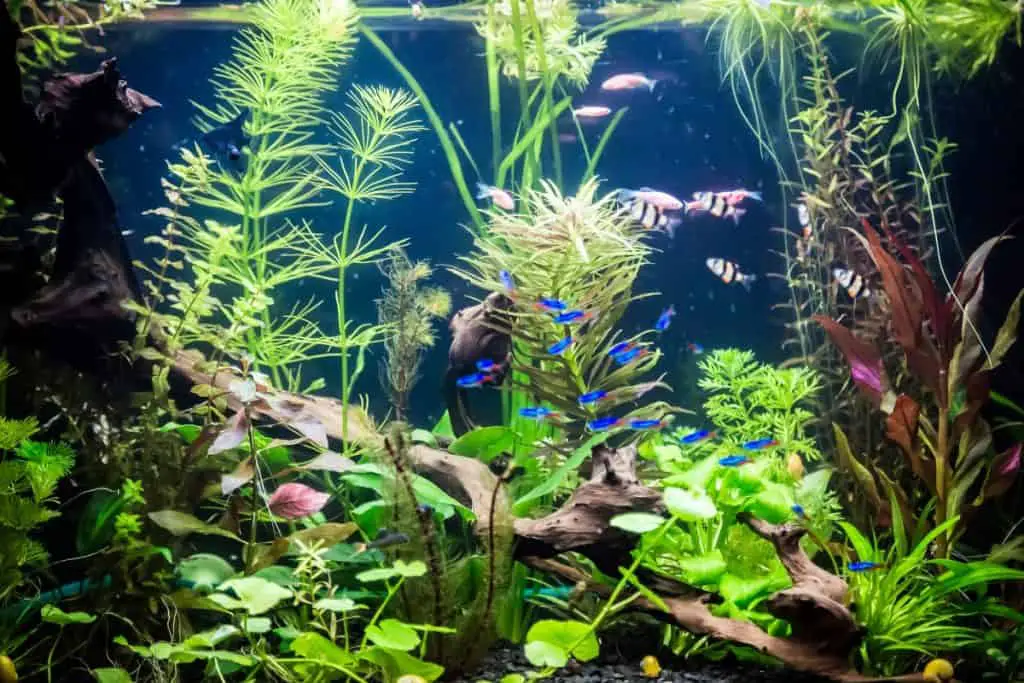
One of the amazing things about fish is the wide variety available. They display a dazzling array of shapes, sizes, and colors. There are literally hundreds of different species that can be found at your local pet store. There’s a fish for every budget, home, and child!
The other great thing is you can easily adopt more than just one. With few exceptions (betta fish) most fish can cohabitate with other species in the same tank. Many fish actually prefer to live in schools than solitarily.
A large aquarium with schools of different types of brightly colored fish is a sight to behold.
5. Require Little Space
A great starter tank for anyone is a simple 10-gallon tank. These tanks have a footprint of 1 x 2 feet. Even a large 75-gallon aquarium only takes up 1.5 x 4 feet. No matter the living situation, everyone can find room for a small aquarium.
If you are comfortable putting the child’s aquarium in their room, put some thought into where you will place it. Make sure it’s on a firm secure surface in a place it isn’t easily bumped or jostled.
6. Inspire Creativity
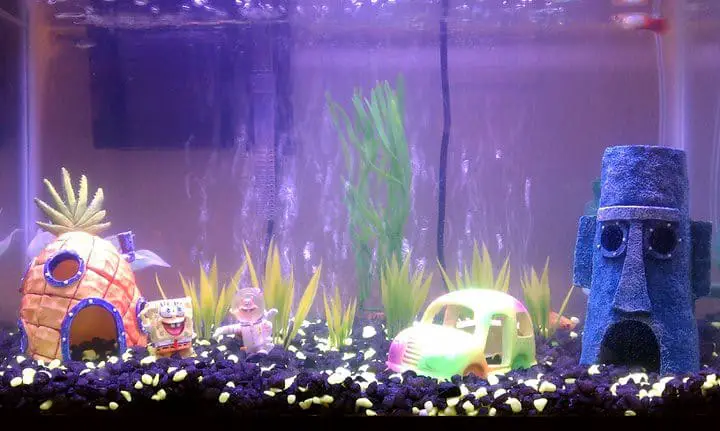
“Balter’s Spongebob Aquarium” by derrich is licensed under CC BY 2.0
Have you ever caught yourself gazing at an aquarium? While the fish are certainly the focus a well-designed aquarium completes the experience.
There are a ton of different types of decor for aquariums. From natural colored plants and gravel to the wildest colors you can think of. There are also a lot of other fun decorations like the classic sunken ship or treasure chest. You could even opt for a themed SpongeBob Bikini Bottom look.
This is a great area you can really give your child free reign. Just be careful not to use random non-aquarium objects as decor. Non-aquarium items can have harmful chemicals and toxins that may kill your fish!
7. Relatively affordable
It’s generally not a good idea to spend a lot of money on a child’s first or even second pet. There is a fair chance that they will eventually lose enthusiasm for their new friend. A simple aquarium kit with a few fish can be had for around $100.
This is generally more affordable than any purebred dog or elaborate reptile habitat.
8. Good For Health
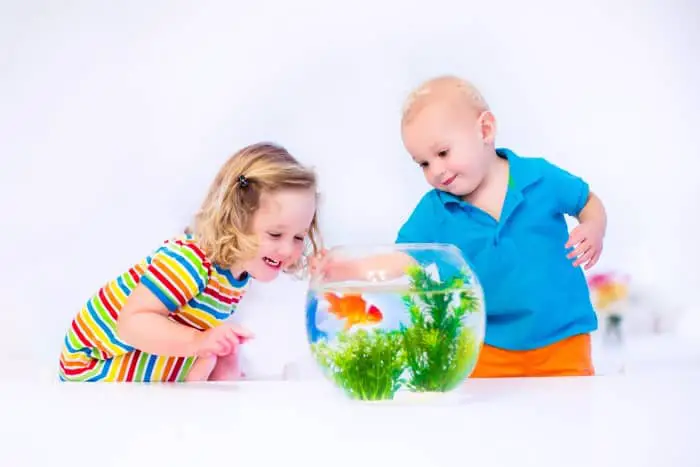
It is widely accepted that cats, dogs, and other pets have a positive effect on a person’s well-being. But did you know that the same can be said about fish?
Fish are peaceful, tranquil, and have been proven to have a calming effect on children. In a world with countless artificial distractions, children need something to help their minds rest and recover. Similar to the way “green spaces” help our mental well-being, a “blue space” in the home can have the same effect on a child.
Furthermore, another study saw improvements in mood, blood pressure, and heart rate in participants of all ages.
Have I Convinced You Yet?
If you made it this far I’ll make the assumption you see some validity to my argument. But where does one start?
First off it’s best to start small. I highly recommend starting with a 10-gallon aquarium kit of some sort. These are small enough to not be a burden, but large enough to give you different fish stocking options.
You also need to put a little thought into what type of fish would be best for your child. Most importantly, you should stick with freshwater fish. Saltwater fish are amazing and beautiful but require more experience and a larger investment.
Hardy live-bearing fish are a great place to start. These include mollies, swordtails, guppies, and betta fish. If you opt for the betta fish please don’t stick them in a little betta bowl or jar. Bettas do best in 5 or 10-gallon aquariums with heat and water filtration. Despite what some people may say.
Final Thoughts
There are many advantages to pet fish that most people don’t even realize. Even if you have decided to go with a different type of pet for your child I hope you found this article informative!

